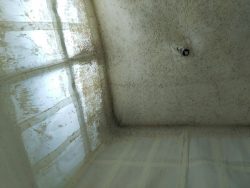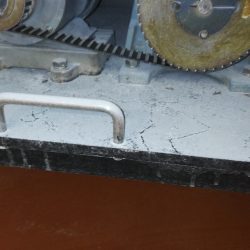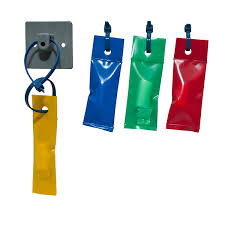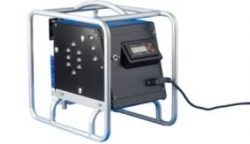I Lepidotteri sono tra gli infestanti più comuni nelle Industrie alimentari dove si lavorano farine e derivati, in particolare Plodia i. ed Ephestia k. creano non pochi problemi per il rischio di contaminazione degli alimenti sia allo stadio larvale che adulto una volta che hanno completato il loro ciclo vitale.
Perchè ci sono i Lepidotteri
Il motivo principale stà nella tipologia produttiva che per sua natura facilita la presenza di farina che si accumula nei macchinari durante la lavorazione, andando a formare all’interno degli strati di farina dove questi insetti proliferano indisturbati protetti dai carter.I ritmi produttivi imposti dal mercato non consentono come una volta la gestione pianificata delle operazioni di fermo produzione, perchè per ammortizzare i costi e venire incontro alle esigenze commerciali della Clientela le macchine devono lavorare incessantemente spesso su tre turni.
Che dire poi della possibile presenza di questi insetti nei silos delle farine e dentro le tubazioni?Episodi di fermo produttivo dovuto ad intasamenti sono ben conosciuti dagli addetti ai lavori e sappiamo le ore che si perdono a ricercare i punti interessati e ripristinarne la funzionalità.

Fig.1 Silos con massiccia infestazione di migliaia di lepidotteri
E’ quindi ora che siamo nel periodo estivo che questo problema si conclama in quanto l’attività degli insetti è al massimo grado di sviluppo.
Cosa e come fare la prevenzione
Sembrerà strano detto da un Disinfestatore ma dobbiamo dire che la pulizia intesa come rimozione delle farine accumulate è il primo e il piu’ importante passo da fare senza il quale non vi è una corretta gestione dei lepidotteri infestanti.
Importante promuovere l’uso degli aspirapolveri al posto delle granate e delle scope che vediamo a volte usare, ma sopratutto evitare i compressori d’aria che sono largamente utilizzati negli stabilimenti e con grande danno perchè l’aria compressa diffonde in aria larve, insetti e sopratutto uova di lepidotteri e non solo che venogono cosi’ dispersi nell’ambiente.
Per questo è importante che la ditta di pulizie sia formata sul problema e comprenda la necessità di rimuovere la farina causa primaria della “Capacità Portante” del sito per questi infestanti.
Al pari del personale Alimentarista anche quello della Ditta di Pulizia puo’ partecipare agli incontri formativi sul Pest Management dove si danno alcuni semplici consigli sul riconoscimento degli infestanti piu’ comuni e sulle tecniche che adottiamo per combatterli.Importante anche spiegare al personale l’importanza di mantenere le trappole nel loro punto avendo cura di non spostarle o peggio romperle.
Fig.2 Fac simile di attestato incontro formativo sulla prevenzione dalle infestazioni
Dove fare la prevenzione
Per una pulizia efficace occorre pulire dove l’occhio non vede, ossia bisogna andare a cercare lo sporco per rimuoverlo bene dai punti nascosti e non limitarsi a pulire dove lo sporco è visibile.Armarsi quindi di chiave inglese e cacciaviti per smontare placche,carter,protezioni e poi procedere con l’aspirazione.

Fig.3 Parte interna di un macchinario con evidenza di tracce di larve e adulti di Ephestia morti.
Consigliamo di chiedere il supporto della squadra dei meccanici che sono preziosissimi collaboratori delle ditta di pulizia e disinfestazione , anzi direi che i meccanici/manutentori sono fondamentali per aiutare i disinfestatori ad una efficace gestione degli infestanti nelle aziende.
La presenza di superfici con accumulo di sporco oltre che rappresentare poi un potenziale focolaio infestativo sono anche un fattore che inficia eventuali trattamenti di disinfestazione, chimici e non chimici, per cui è fondamentale procedere a pulizie approfondite al fine di massimizzare l’efficacia della Gestione degli Infestanti
Monitoraggio con feromoni
Largamente utilizzato per comprendere gli andamenti quali-quantitativi delle infestazioni questo metodo si dimostra ottimo anche per bloccare sul nascere eventuali micro-infestazioni occasionali in ambienti “vergini” .
I feromoni oggi in commercio nel mercato della disinfestazione sono tutti molto efficaci anche se consigliamo di provarne alcune marche sul campo per individuare il piu’ adatto alla situazione specifica.Un fattore importante è la collocazione delle trappole sia a livello di dimensionamento (n base al feromone usato questo copre una superficie piu’ o meno estesa) che di ubicazione, in quanto specie per l’Ephestia k. questa a livello adulto tende a spostarsi camminando senza volare per cui una trappola vicina al macchinario infestato catturerà molto di piu’ rispetto ad un altra trappola che anche fosse solo a due metri di distanza.
La Confusione sessuale
Sistema piu’ evoluto basato sull’uso di molecole che diffuse in sovradosaggio mandano in tilt i recettori dei maschi adulti dei lepidotteri che infatti è possibile vedere appoggiati alla parete incapaci di seguire scie feromoniche distinte tanto che spesso cadono esausti sul pavimento.Questo sistema non sostituisce l’uso dei feromoni attrattivi ma puo’ essere considerato un sistema ecologico integrato di controllo con il quale risolvere infestazioni nel medio-lungo periodo.

Fig.4 Blister di feromoni per la Confusione sessuale Dismate
Il Controllo delle infestazioni
Sulle tecniche di controllo vorrei solo fare qualche cenno senza addentrarmi oltre perchè lo scopo di questa riflessione è puntare l’accento sulla prevenzione e non sulla disinfestazione.
Controllo chimico con insetticida nebulizzato
Sistema tradizionale che ha trovato negli ultimi anni un valido aiuto nelle nuove attrezzature che sfruttano la tecnologia dell’Ultra Basso Volume (ULV) con la quale è possibile con alcuni particolari (e costosi) prodotti insetticidi creare una nebbia finissima dove le particelle restano in sospensione per lungo tempo, creando quell’effetto “fallout” che aumenta notevolmente l’abbattenza degli insetti.

Fig.5 Apparecchio per la nebulizzazione di insetticida a ULV
Bisogna dire pero’ che la disinfestazione eseguita a posteriori a seguito di infestazione conclamata costituisce un intervento straordinario che ha lo scopo di riportare l’infestazione al di sotto dei limiti critici, in un momento pero’ in cui l’infestazione stessa è praticamente sfuggita di mano.In sostanza si tratta in molti casi di “chiudere la stalla quando i buoi sono scappati” e questo confligge con i principi del Pest Management.
Ha inoltre un ridotto effetto preventivo in quanto i tempi di azione dei prodotti chimici spesso sono molto limitati,specie quegli che si usano nelle Aziende Alimentari che sono a base di Piretro la cui residuabilità in certi casi è di qualche ora, massimo un giorno, per cui non hanno alcun effetto su insetti che si presentassero successivamente ma questo è anche un bene perchè impedisce che il prodotto rimanga nell’ambiente rischiando di contaminarlo.
I prodotti chimici non hanno poi in nessun caso effetti su uova e larve.
Controllo Chimico con Gas Tossico
E’ un metodo di disinfestazione radicale, laddove è possibile attuarlo, basato sull’uso di gas tossici.Questi interventi sono eseguite da poche ditte specializzate ed autorizzate
Hanno il pregio di essere efficaci contro tutti gli stadi larvali e di scomparire una volta che la struttura è riaperta ma limite della notevole tossicità che ne condiziona la fattibilità operativa, specie in contesti urbani o laddove la struttura non sia adeguatamente isolata da altre costruzioni.
In questa sede non parlero’ poi di altri limiti operativi della disinfestazione chimica costituiti dal dover eseguire interventi a stabilimenti chiusi, possibili problemi di contaminazione chimica,ecc.
Controllo non chimico: Il Calore
Sistema in crescita negli ultimi anni, come il gas tossico ha un’ottima efficacia contro tutti gli stadi degli insetti.Presenta alcune particolarità operative legate alla natura dei fabbricati e che devono essere valutate per verificarne la perfetta efficacia.
Non ha effetti residuali e quindi questo è un bene perchè non vi sono rischi di contaminazione post-intervento.
Conclusioni
Concludo dicendo che in un sistema virtuoso la gestione dei Lepidotteri deve essere perseguita tramite un approccio sistematico che prenda in considerazione tutti gli aspetti coinvolti, partendo dalla prevenzione tramite una pulizia continua e passando per un monitoraggio costante e la cui analisi aiuti il Tecnico a individuare le zone maggiormente critiche e solo in ultima analisi l’esecuzione di una disinfestazione come azione correttiva improcrastinabile e non come prassi operativa.
Rosi Norman
CQ Romani Disinfestazioni Srl Lucca.
www.romanidisinfestazioni.com
English version
Lepidopteras in a Food Factory
Lepidopteras and particularly Plodia i and Ed Ephestia k are among the most common type of pests in the Food Industries where flour and simalar products are being used. Pests create a lot of problems regarding food contamination during their life cycle, both at the larval stage and at the adult stage.
Why Lepidoptera?
The main reason lies in the type of production which, by its nature, facilitates the presence of flour that accumulates in the machinery during processing, and forms within the layers of flour where these insects proliferate undisturbed protected by the hulls. For the sake of production cost, the planned productions doesn’t allow time to stop, check and clean the machinery on a regular basis. Factories are focused on meeting the market’s need, optimizing production by making the machinery work constantly on a three shift basis, reducing costs etc.
What about the possible presence of these insects in the flour cilos and in the pipes? Episodes of stopping the production are wellknown among factory workers and we are very well awair of the production hours lost searching for the problem and restoring functionality.

Fig.1 Cilos with massive infestation of thousands of Lepidopterans
Now, during summer, where the activity of the insects is at the highest level, the factories faces most problems with pests.
What and How to Prevent
It might seem as a strange advise from a Disinfestrator, but we have to say that prevention – regular cleaning and removal of accumulated flour etc. – is the first and most important step for management to avoid a weed moths.
It is important to recognize the use of industrial vacuum cleaners instead of grenades and other scopes, that we sometimes see.
Above all, avoid the air compressors that are widely used in the plants and with great damage because compressed air spreads into the air larvae, insects and Especially lepidoptera eggs and not only that they are so dispersed in the environment.
For this it is important that the cleaning companies are informed of the problem and understand the need to remove the primary cause flour of the “carrying capacity” of the site for these weeds.
Like the Alimentarist staff, that of the Cleaning Company can take part in training sessions on Pest Management where they give some simple advice on the recognition of the most common pests and the techniques we adopt to combat them. It is also important to explain to the staff the importance of Keep the traps in their place while taking care not to move them or to break them.
Fig.2 Fac similar to attestative training meeting on the prevention of infestations
Where to Prevent
For effective cleaning you need to clean where the eye does not see, that is, you have to go looking for dirt to remove it from hidden spots and not just to clean where the dirt is visible. Then use a wrench and screwdrivers to disassemble plaques, Protections and then proceed with aspiration.
Macchinario_infestato
Fig.3 Internal part of a machine with evidence of larvae and adult deaths of Ephestia.
We would like to ask for the support of the team of mechanics who are very valuable contributors to the cleaning and disinfestation firm, and I would say that the mechanics / maintainers are essential to helping the pimpers to effectively manage the weeds in the farms.
The presence of surfaces with dirt build-up as well as posing a potentially infestable outbreak are also a factor affecting any chemical and non-chemical disinfestation treatments, so it is essential to perform thorough cleaning in order to maximize the effectiveness of Pests
Monitoring with pheromones
Largely used to understand the quantitative-quantitative trends of infestations, this method is also good for blocking the emergence of occasional micro-infestations in “virgin” environments.
Pheromones today on the market in the pest control market are all very effective although we recommend trying out some brands on the field to find the most suitable for the specific situation. An important factor is the location of the traps both at the sizing level (n based on pheromone Used this covers a more or less extended area) than of a location, as species for the Ephestia k. This adult-level tends to move by walking without flying, so a trap near the haunted machine will capture much more than another trap that would be just two yards away.
Sexual Confusion
The most advanced system based on the use of molecules spreading in overdose casts adult adult mothers receptors, which in fact can be seen on the wall that are incapable of following distinct pheromone sciences so often they fall exhausted on the floor. This system does not replace The use of attractive pheromones but can be considered as an integrated ecological control system with which to resolve infestations in the medium to long term.
Fig.4 Pheromone Blisters for Sexual Confusion Dismatise
Control of infestations
On the control techniques I would just like to make a few nods without going further because the purpose of this reflection is to focus on prevention rather than on disinfestation.
Chemical control with nebulized insecticide
Traditional system that has found in recent years a valuable help in new equipment that utilizes Ultra Low Volume (ULV) technology with which it is possible with some particular (and expensive) insecticide products to create a finest fog where the particles remain in suspension For a long time, creating that “fallout” effect that dramatically increases the insect fatigue.
Fig.5 ULV Insecticide Spraying Device
It is to be said that the disinfestation carried out after incessant infestation is an extraordinary intervention aimed at bringing the infestation back to the critical limits, at a time when the infestation itself is virtually escaped Hand. Basically, it is in many cases “to close the stable when the oxen have escaped” and this conflicts with the principles of Pest Management.
It also has a reduced preventive effect since the time of action of chemicals is often very limited, especially those used in Pure Food companies, whose residuals in some cases are of a few hours, a maximum of one day, to Which have no effect on insects occurring subsequently but this is also good because it prevents the product from remaining in the environment and may contaminate it.
In any case, chemicals do not have any effects on eggs or larvae.
Chemical Control with Toxic Gas
It is a radical disinfestation method where it can be implemented, based on the use of toxic gases. These interventions are carried out by a few specialized and authorized firms
They have the advantage of being effective against all larval stages and disappearing once the structure is reopened but limits the considerable toxicity that affects its operational feasibility, especially in urban contexts or where the structure is not adequately isolated from other constructions.
Here I will not speak of other operational limitations of the chemical disinfestation of having to carry out operations at closed plants, possible chemical contamination problems, etc.
Non-chemical control: Heat
A system that has been growing in recent years, as toxic gas has a great effect against all insect stages. It has some operational features linked to the nature of the buildings and needs to be evaluated in order to verify their effectiveness.
It has no residual effects and therefore this is good because there are no risks of post-intervention contamination.
Conclusions
I conclude by saying that in a virtuous system the management of Lepidotteri must be pursued through a systematic approach that takes into account all aspects involved, starting from prevention through continuous cleaning and passing on a constant monitoring and whose analysis helps the technician to identify the Most critical areas and only ultimately the execution of a disinfestation as a corrective action improvised and not as operating practice.
Rosi Norman
Romani Disinfestazioni Srl LUCCA Tel 0583-955344 Cell 337-1238029
Controllo Qualità


